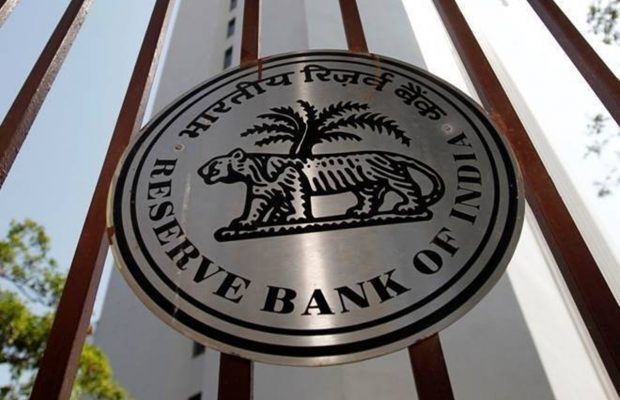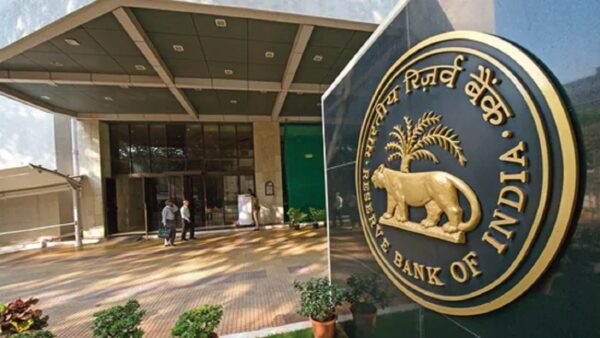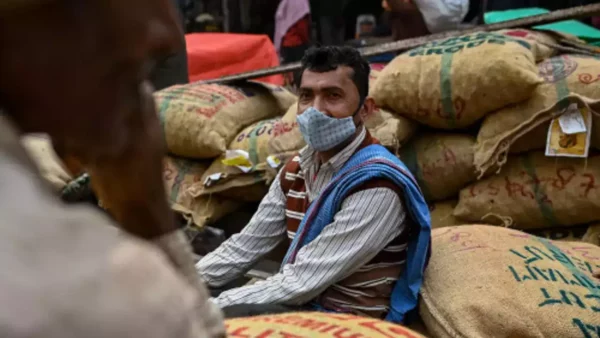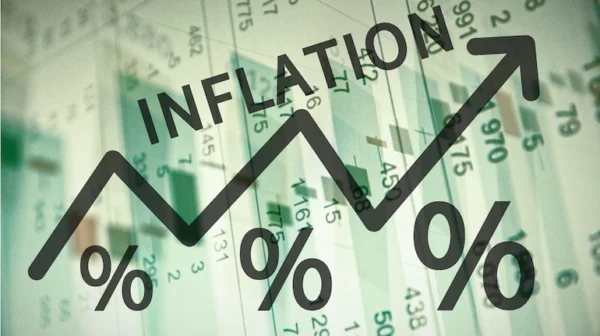Is RBI Able To Control Inflation? How India Is Rapidly Running Towards Srilanks Footsteps

Is RBI Able To Control Inflation? How India Is Rapidly Running Towards Srilanks Footsteps
Inflation is defined as an increase in prices caused by an excess supply of money and credit relative to the commodities and services provided. As the average person understands it, inflation is the rise in the price of a set of goods and services in a given economy over time. A price index’s percentage rate of change is used to calculate it.
Given the vast disparities between the rich and the poor on the one hand and the rural and urban on the other, inflation in India is a major source of concern. Inflation is robbing the poor and hurting others, though somewhat. The benefits of the much-touted economic expansion have yet to reach substantial population segments, particularly in rural areas.
The benefit of high consumer prices does not trickle back to primary producers under current conditions. Still, it is sucked away by intermediaries and speculators who enjoy a free run in a shortage economy. Inefficiencies in the physical market remain unaddressed if attention to agriculture is limited to lip service. In recent years, shortages of vital commodities have grown as output has lagged behind demand. Because of the increased worldwide market prices, imports have grown more expensive.
It’s worth remembering that inflation isn’t something that happens immediately. It’s harmless to the extent that it gives you time to get some protection. The Reserve Bank of India is responsible for controlling and reversing the inflation situation in India.
The Reserve Bank of India (Amendment) Act, 2006 allows the Reserve Bank complete discretion over the percentage of scheduled banks’ demand and time obligations that must be held as Cash Reserve Ratio (CRR). As a result of the modification, no interest will be paid on CRR balances to improve the CRR’s efficacy as a monetary policy tool, as interest payment reduces the CRR’s effectiveness.
Instead of focusing solely on inflation, the Reserve Bank of India (RBI) uses a multi-indicator approach to achieve its goals of growth, price stability, and financial stability. Of course, this attracts the wrath of mainstream economists. RBI appears befuddled, ineffective, and, in many cases, a cause of the issues it aims to solve in its attempt to balance various objectives that often contradict with one another.
The Reserve Bank of India, or RBI, is India’s central bank and regulatory organisation overseeing the country’s financial sector. It is owned by the Government of India’s Ministry of Finance. It is in charge of issuing and distributing the Indian rupee. It oversees the country’s primary payment networks and aims to further its economic growth. Bharatiya Reserve Bank is a central bank in India. Note Mudran is one of the RBI’s specialised departments in charge of printing and minting Indian banknotes and coins.
The RBI formed the National Payments Corporation of India as a specialised division to regulate India’s payment and settlement systems. The Reserve Bank of India started the Deposit Insurance and Credit Guarantee Corporation as one of its specialised divisions to provide deposit insurance and credit guarantee to all Indian banks.
It had complete control of monetary policy in the country until the Monetary Policy Committee was constituted in 2016. In compliance with the RBI Act, 1934, it began operations on April 1, 1935.
The governor, four deputy governours, two finance ministry representatives (usually the Economic Affairs Secretary and the Financial Services Secretary), ten government-nominated directors, and four directors representing local boards for Mumbai, Kolkata, Chennai, and Delhi make up the RBI’s 21-member central board of directors. These local boards comprise five persons representing regional, cooperative, and indigenous bank interests.
The Asian Clearing Union has accepted it as a member bank. The bank is a leading member of the Alliance for Financial Inclusion, promoting financial inclusion policies.
On November 12, 2021, India’s Prime Minister, Narendra Modi, announced the intro of two new initiatives to increase investment and provide greater protection for investors.
The RBI Retail Direct Scheme and the Reserve Bank Integrated Ombudsman Scheme are the two new schemes. The RBI Ordinary Direct Scheme allows retail investors to buy government securities quickly and easily. According to the RBI, the initiative will enable individual investors to free open and manage government securities accounts.
The RBI Integrated Ombudsman Scheme aims to strengthen the grievance redress mechanism for customers who have complaints against the central bank’s regulated firms. The Reserve Bank of India requires all Indian banks to keep a safe box in their substantial room.
However, the exception is given to the Regional Banks and the SBI branches located in the rural areas, but a substantial room is compulsory.
Repo rate
The repo rate, also known as the benchmark interest rate, is the rate at which the RBI lends money to commercial banks for a short period (a maximum of 90 days).
Borrowing from the RBI becomes more expensive as the repo rate rises. If RBI wants to make borrowing money more expensive for banks, it raises the repo rate; conversely, it lowers the repo rate if it wants to make borrowing money cheaper. Banks cannot make a profit when this rate is raised, and when this rate is reduced, the converse occurs. Repo rates are lowered anytime a country needs banking and economic development.
If banks want to borrow money from RBI for a short period of time, they must pay this interest rate. As collateral, banks must pledge government securities. A repurchase agreement is used in this situation. If a bank wishes to borrow, it must first furnish government securities worth at least $1 billion (perhaps more due to the margin requirement of 5%–10% of the loan amount) and promise to repurchase them for $1.07 billion (US$14 million) after the borrowing period. As a result, the bank has paid interest of $65 million (US$850,000). This is why it’s called a repo rate.
The government securities used as collateral by banks cannot come from the SLR quota (otherwise, the SLR will go below 19.5 per cent of NDTL and attract penalties).
To combat inflation, the RBI increased the repo rate, resulting in higher borrowing costs for banks. Banks will pass on the increased costs to their consumers, increasing the cost of borrowing across the economy. Fewer people will apply for loans, resulting in a reduction in overall demand. Inflation will be reduced as a result. The Reserve Bank of India (RBI) employs the opposite method to combat deflation. When the RBI decreases the repo rate, banks are not lawfully required to lower their base rates.
At the moment, the repo rate is 4%.
Reverse repo rate
As the name suggests, the reverse repo rate is the opposite of the repo rate. Commercial banks deposit excess funds with the Reserve Bank of India is a short-term borrowing rate. When the reserve bank believes there is an excess of money in the banking system, it employs this mechanism. The RBI will pay banks a greater interest rate if the reverse repo rate rises. As a result, banks prefer to lend money to RBI, which is always safe, rather than to others (people, corporations, etc.), who are always dangerous.
Statutory liquidity ratio (SLR)
Apart from the CRR, banks must keep liquid assets like gold, cash, and approved securities on hand. Higher liquidity ratios encourage commercial banks to keep a more significant proportion of their assets in liquid form, limiting their ability to provide loans and advances and having an anti-inflationary effect. A higher liquidity ratio causes bank funds to be diverted from loans and advances into government and approved securities.
Central banks in well-developed economies use open market operations, which involve the central bank buying and selling eligible securities in the money market, to influence the volume of cash reserves held by commercial banks and thus the volume of loans and advances they can make to the commercial and industrial sectors. Government securities are traded on the open money market at market-related interest rates. In recent years, the RBI has used open-market operations more frequently.
Bank rate
The bank rate is defined as the “standard rate at which RBI is prepared to acquire or rediscount bills of exchange or other commercial papers eligible for acquisition” in Section 49 of the RBI Act of 1934. The RBI charges banks the interest rate when they seek to borrow long-term cash from the RBI. The current value is 4.65 per cent.
Liquidity adjustment facility (LAF)
In the year 2000, the liquidity adjustment facility was implemented. The Reserve Bank of India provides scheduled commercial banks the LAF facility to access liquidity in times of need or store excess money with the RBI overnight against the collateral of government securities.
The Reserve Bank of India accepts applications for a minimum of 5 crores (US$660,000) and in multiples of 50 million beyond that.
Cash reserve ratio (CRR)
CRR is the ratio of a bank’s cash reserve holdings with the RBI to the bank’s net demand and time obligations to ensure the scheduled banks’ liquidity and solvency. The percentage of net demand and time obligations banks must keep in cash at the Reserve Bank of India. CRR has been fixed at 4% by the RBI. A 1% change in CRR has a $137,000 crore impact on the economy. A rise subtracts this amount from the economy, whereas a reduction adds it back in. If a bank has 2 billion NDTL (US$26 million), it must keep 80 million NDTL (US$1.0 million) in cash with the RBI. The RBI does not pay interest on CRR.
Assuming the economy is experiencing inflationary trends, the RBI wishes to keep the situation under control by altering the SLR and CRR. If the RBI raises the SLR to 50% and the CRR to 20%, the bank will only have $600 million (US$7.9 million) to operate with. With such little capital, the bank will find it challenging to remain profitable. The bank will have no choice except to hike its interest rate, making borrowing more expensive for its consumers. As a result, total demand will be reduced, and prices will fall.
Open market operation (OMO)
The activity of buying and selling government securities in the open market to manage the availability of money in the banking system is called open market operation. When there is an excess of money, the central bank sells government assets, draining the excess liquidity out of the system. When liquidity is scarce, the RBI will purchase its assets and infuse money into the economy.
The Reserve Bank of India would inject Rs 1 trillion (short scale) into the economy on March 23, 2020, through a term repo auction and a major OMOs (open market operations) purchase of government assets. Because COVID-19 outbreak in India, the Reserve Bank keeps a close eye on financial market conditions and the economy’s liquidity situation.
Marginal standing facility (MSF)
This plan was first announced in May 2011 and is open to all scheduled commercial banks. Banks can borrow up to 2.5 per cent of their net demand and time obligations.
The RBI accepts applications for a minimum of ten million dollars and multiples of ten million dollars beyond that.
The main distinction from the repo rate is that the bank can use its SLR quota to pledge government assets (up to one per cent). By pledging SLR quota securities under MSF, the bank will not be penalised if SLR falls below 20.5 per cent. The current marginal standing facility rate is 4.25 per cent.

5 indicators that RBI dropped the ball on managing inflation
The Reserve Bank of India has stated that growing inflation is a concern. The RBI thinks that by boosting the repo rate, individuals will be encouraged to spend less and save more, lowering demand in the economy and, as a result, prices.
On two levels, the decision to conduct such a meeting and raise interest rates is both surprising and apparent. It’s unusual given the RBI’s MPC meets every two months, and the meeting this week was not scheduled. The MPC convened in February and April, and another meeting was planned for June.
On the other hand, the RBI’s actions are not surprising — evidence has been gathering for some time that the RBI, whose primary responsibility is to preserve price stability and manage inflation, is failing to do so.
In fact, the RBI’s surprise rate hike is only the latest example of how it has consistently miscalculated inflation and opted to ignore rising prices. Here are five markers illustrating how far behind the curve the RBI is.
1. For more than two years, inflation has been growing.
The RBI is required by law to aim for a retail inflation rate of 4%. The law does, however, offer the RBI considerable discretion, allowing retail inflation to fluctuate by two percentage points in either direction. As a result, the RBI might allow for 2% or 6% inflation in any given month.
The important aspect to remember is that overall inflation should be under 4%. The range of 2% to 6% does not imply that the RBI can keep inflation at that level on a consistent basis. This is crucial to comprehending how RBI failed to achieve its goal.
There has only been one month since October 2019 when retail inflation has been close to 4%. In all other months, including the nationwide Covid-19 lockout in 2020, inflation remained well above 4% and frequently approached 6%.
2. The inflation was not “temporary”.
Although the reasons for high inflation have shifted throughout time, overall inflation has remained high. It has been fueled by high crude oil costs and hefty taxes on such fuels – as it is now – and it has also been fueled by food shortages, maybe due to unexpected rainfall.
Despite this, the RBI has openly emphasised promoting growth – by keeping interest rates low – over managing inflation for the most part since October 2019. She frequently refers to monthly inflation as “temporary.”
Gov. Das has stated repeatedly that the RBI will do “everything it takes” to stimulate growth. However, because of this approach, inflation remained high, causing the poorest to suffer the most – at a time when the economic collapse had already robbed millions of poor and middle-class people of their salaries and savings.
3. The rise in crude oil prices is not new.
The RBI pointed to high crude oil prices in the aftermath of the Ukraine war as one of the key causes of India’s high inflation in a statement released on Wednesday.
High crude oil prices, on the other hand, were well known to the RBI not only in April, when it convened for its most recent review, but also in February, when it surprised everyone by forecasting inflation at just 4.5 per cent for the coming year.
4. High core inflation is not new either.
“Core inflation is projected to remain elevated in the coming months, reflecting high domestic pump prices and pressure from necessary medicine prices,” according to the Reserve Bank of India. It also reveals that, as headline retail inflation eased, core inflation (which is effectively the inflation rate excluding the impact of fuel and food costs) began to grow last year.
In February, Nomura Research produced research titled Headline and Core Inflation Converge at ‘Six,’ revealing that both headline and core inflation were at 6%.
The rising core inflation is often more concerning because it takes longer to climb and decline. Though core inflation rises and falls slowly, food and gasoline prices are notoriously volatile.
As a result, if core inflation is at 6%, the RBI should be more concerned and may take action.
5. Monetary policy has lagged. The RBI has waited too long.
The economy is generally thought to react instantly when the RBI rises or decreases interest rates. That, however, does not occur. Even though “monetary policy transmission” has improved with time, it could take weeks to reach its full capacity.
To put it another way, if the RBI wanted to keep inflation under control in May, it should have intervened in February or, at the very least, April. Raising interest rates currently may not result in rapid reductions in inflation.

Explained: ‘India looks a lot like Sri Lanka’?
The ongoing economic crises in Sri Lanka and Nepal symbolise the governments at the head of both countries’ incorrect policies. However, several economists and specialists have drawn a link between India’s weak fundamentals and Nepal’s and Sri Lanka’s current economic conditions. Some people went on to say that the Indian economy’s weak foundations could lead to a full-fledged economic disaster in the future. However, former finance secretary Subhash Chandra Garg refutes these allegations, claiming no economic comparison between India and Sri Lanka exists.
“I don’t believe the Sri Lankan crisis is comparable to any other problem India may confront. Sri Lanka has been adopting a foolish policy of over-borrowing from overseas without the ability to service debt for many years. So, that is one reason; the second reason is that Sri Lankans have been dreadful at taxation and thus have been unable to raise taxes. Garg explained that they’ve also been excessively liberal with their spending plans, “Garg explained.
For the past 7-10 years, he claims, everything that could go wrong in the Sri Lankan policy framework has gone wrong. He links the economic catastrophe to issues such as weak taxation policy, excessive spending, and extremely risky foreign borrowing, notably borrowing from the Chinese.
He went on to say that India’s tax-to-GDP ratio is a little low and that our spending management hasn’t been overly liberal or foolish.
“We have not over-borrowed overseas; in fact, we have under-borrowed abroad, and the majority of what we own is domestic. Also, instead of being underfunded, we have very big foreign reserves, which actually add to the cost of government, “Garg explained.
Most people have talked about inflation for the past two or three months. The government’s cost-push inflation (CPI) data for April 2022 also shows that the inflation rate was 7.9%, provoking public dissatisfaction. The exponential rise in the prices of vegetables, fruits, grains, edible oil, and gasoline has alarmed the general people. Let’s take a closer look at the phenomenon.

Inflation can be classified into three categories:
Demand-Pull Inflation is caused by a combination of high demand and limited supply. Increasing consumer confidence, economic development, money circulation or velocity, cheap credit availability from the banking sector, strong government spending and tax cuts, and high consumer expectations all contribute to increased market demand. An overabundance of money in the market creates demand, and supply becomes scarce, leading to market inflation.
Cost-Push Inflation occurs when the cost of manufacturing rises due to increased input costs such as raw materials and other inputs such as labour, and the final sale price rises as a result. An increase in the currency rate causes this sort of inflation, which results in higher import costs. High public debt, which results in currency printing and devaluation, high input costs, increased taxation, and monopoly or duopoly in a few sectors are the main causes of cost-push inflation.
Built-In Inflation refers to a situation in which inflation rises gradually over time. An increase in wages, as it does every year, boosts the cost of the product, but the worker, on the other hand, stimulates demand due to the wage gain. This sort of inflation is thought to be necessary for economic growth.
Inflationary episodes have not just harmed India but have also harmed the economies of other countries throughout the world. Sri Lanka is on the verge of collapse owing to hyperinflation. A few people — call them pro-Left economists or anti-establishment, whatever you want to call them — are scaring the public by claiming that India has entered the era of hyperinflation through speeches, publications, and tweets. These are the individuals that just consider one side of the coin.
Inflation has clearly become a universal concept in the previous two months. Countries with low inflation in the preceding decade, such as the EU, the United Kingdom, the United States, France, and others, are now experiencing hyperinflation. When compared to other countries’ inflation stats, India bids well. Primary articles, such as food and grocery, power and fuel, and manufactured products, which include things such as base metal, chemicals and chemical products, machinery, textiles, and so on, are taken into account in the calculation of inflation.
Demand-pull, cost-push, and inbuilt inflation all contribute to present inflation. The Indian government’s COVID-19 stimulus packages resulted in the country’s highest-ever money circulation, which now stands at over Rs 31 lakh crore. Similarly, India is predominantly an importer, and inflation in other major supplier countries due to the Russia-Ukraine conflict is lowering the cost of inputs such as petroleum, metals, and chemicals, as well as rising inflation.
Cost-push inflation is influenced by the rupee’s exchange rate against the dollar. Because India is still developing, it is spending extensively on subsidies for the poor and needy, whose intrinsic inflation exacerbates the inflation problem.
The RBI recently raised the base rate and the cash reserve ratio, draining about Rs 1 lakh crore from the market. It is hoped that more such decisions, such as raising the base rate by 1% and raising the CRR and SLR, will be made at the upcoming Monetary Policy Committee (MPC) meeting in the first week of June.
Aside from monetary policy, which aims to reduce demand-pull inflation, cost-push inflation can be combated by combining public and government efforts. The government is buying crude oil in bulk from Russia to combat rising fuel prices throughout the world at the expense of diplomatic relations with wealthy countries. As our rupees have become stronger compared to other major currencies except for the dollar, the government should take greater steps to interact with other countries in currencies other than the dollar.
The general public should also purchase indigenous products to keep their current account balance within acceptable bounds and strengthen our currency. They should also avoid asking for subsidies or freebies so that money can be spent on capital items that create jobs. If the Russia-Ukraine conflict continues and the supply situation stays normal, this inflation will endure in the short run.



